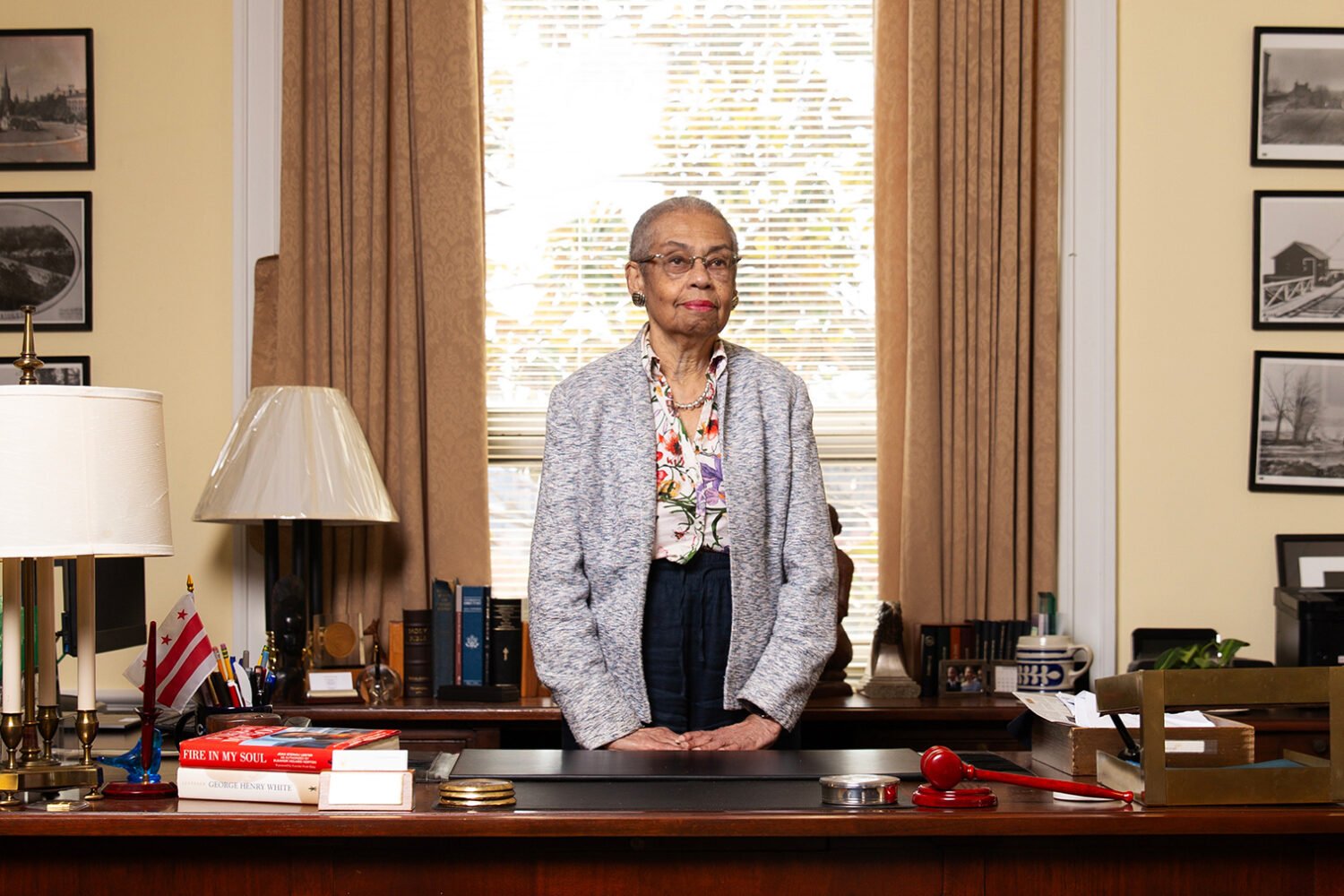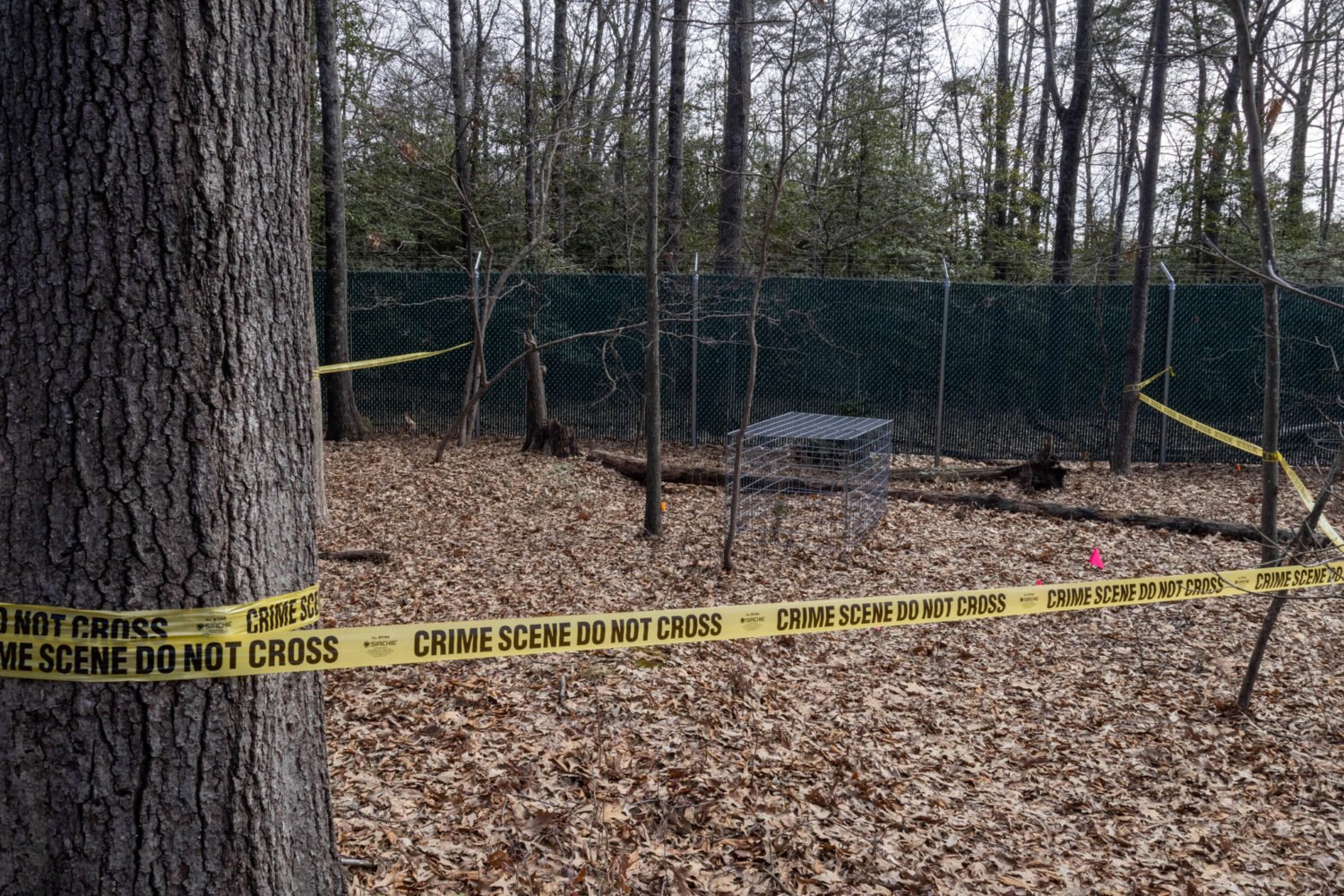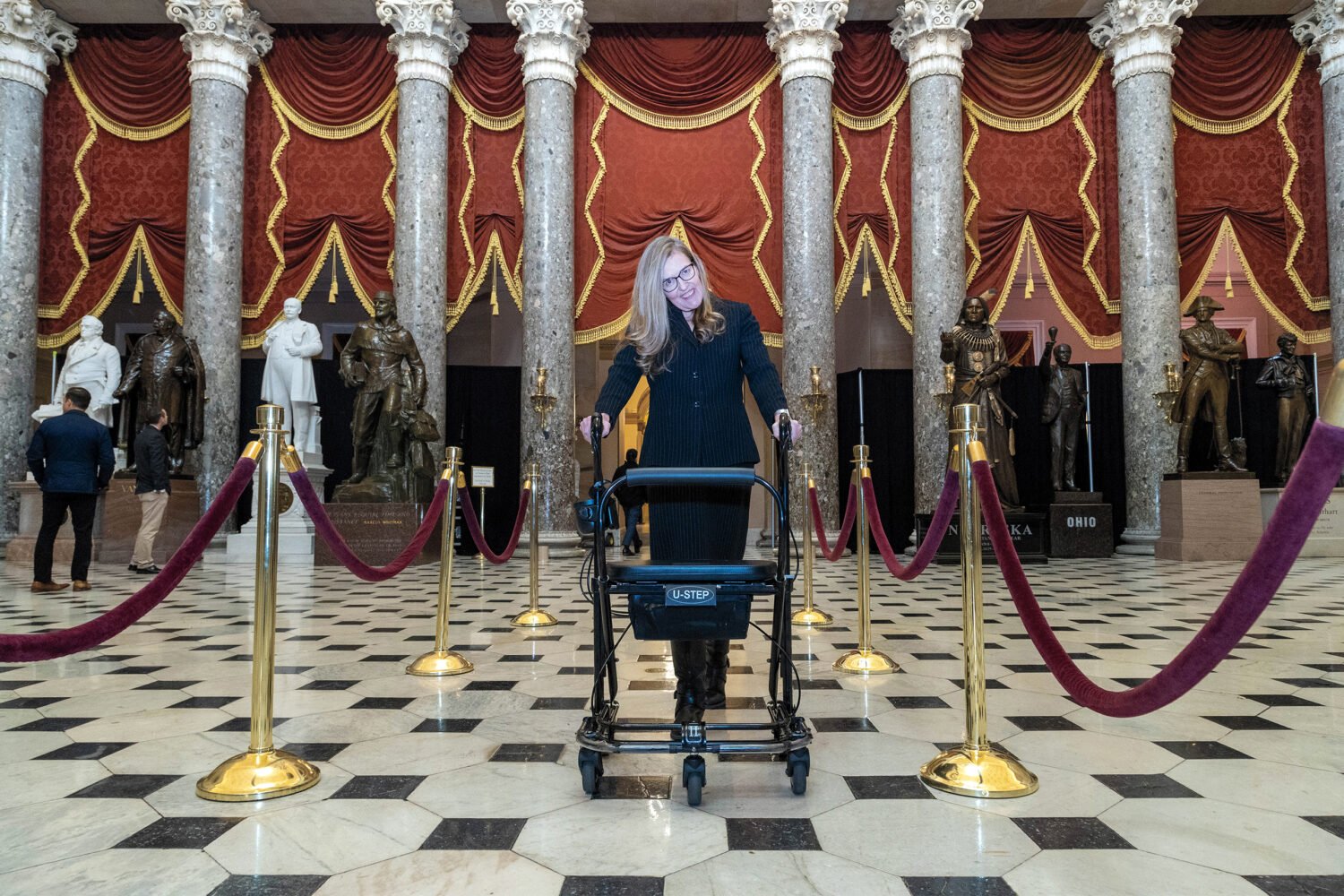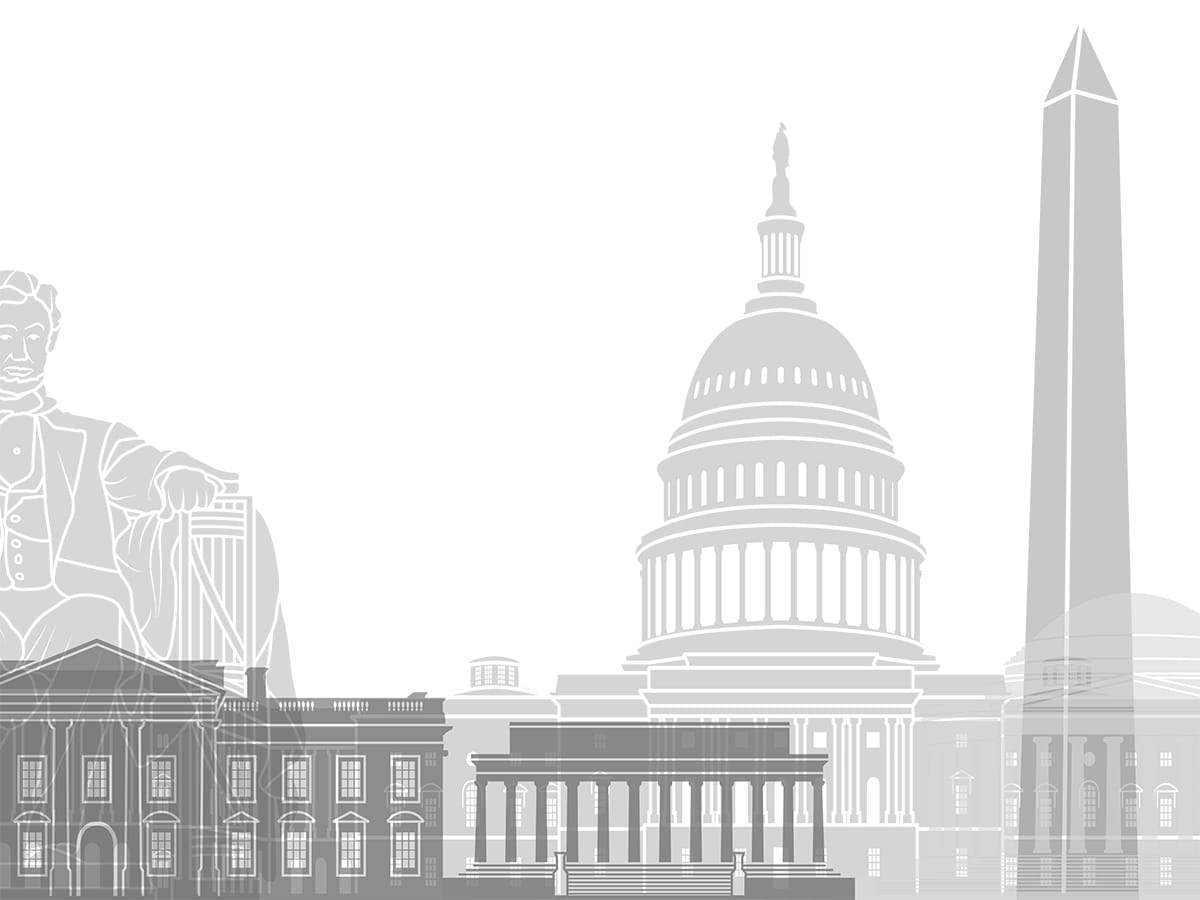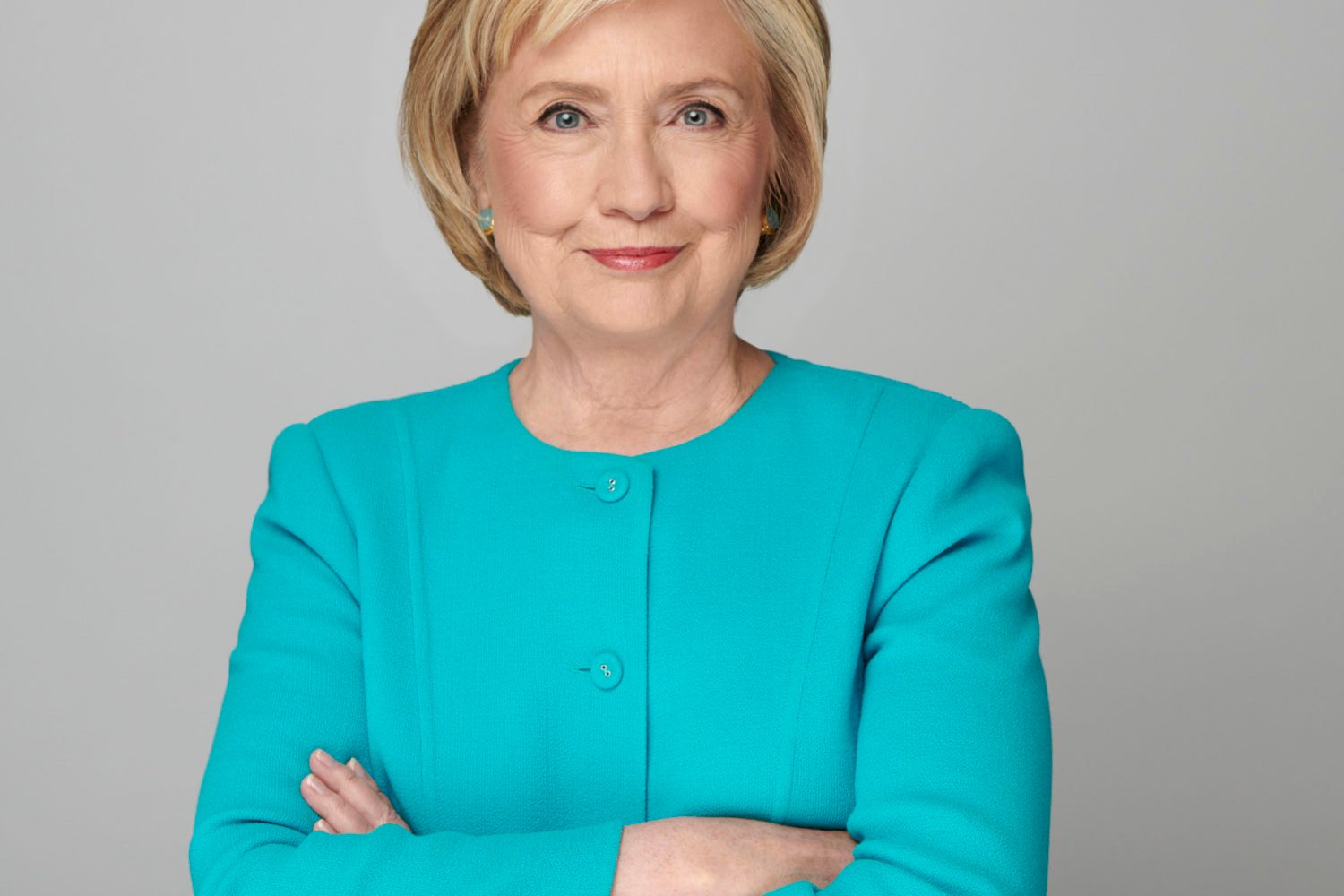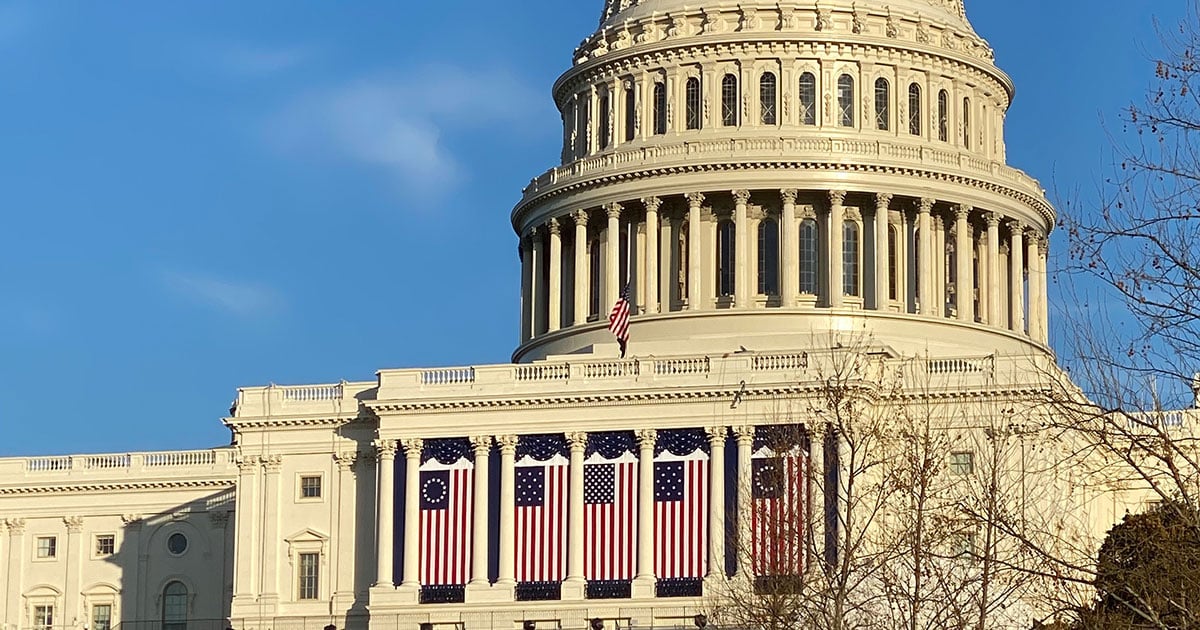Anne-Marie Slaughter looked exhausted.
It was late summer 2017, and for the past week her Washington think tank had been at the center of a national media scandal, beginning with an embarrassing New York Times story about her firing of a certain employee. Slaughter, the president and CEO of New America, had been vacationing in Italy when the news broke. Now she was back, about to confront her bewildered organization at an all-staff meeting and to try to do some damage control.
The ousted staffer, Barry Lynn, was a critic of big tech companies and headed Open Markets, a New America program on corporate power and monopolies. Earlier in the summer, he had gone out of his way to praise the European Union for fining Google $2.7 billion for antitrust violations.
The chairman of Google’s parent company at the time, Eric Schmidt—who, along with his foundation and Google, had by that point donated nearly $20 million to New America—was not pleased, Lynn told the Times, and called Slaughter to say so. Lynn was informed that his actions had endangered the institution, and he was ultimately fired.
The debacle raised all sorts of questions about New America’s coziness with corporate funders, and as staffers gathered in the conference room—across the lobby from the “Eric Schmidt Ideas Lab”—they were impatient for answers. Many worried that the think tank’s intellectual integrity had been compromised, and they feared for their reputations. What would happen the next time someone’s work ran crosswise with the interests of a big donor?
Instead of stanching the anxiety, Slaughter stoked it. According to a recording of the meeting, she said that while she recognized that the standard in journalism was never to show sources what you were writing, New America’s “norm can’t be that. We’re an organization that develops relationships with funders. And you know, these are not just black boxes; they’re people. Google is a person, the Ford Foundation—these are people. . . . And particularly when they give you money, which is really a nice thing . . . basic courtesy I think requires—if you know something really bad, you say, ‘Here’s a heads-up.’ ”
Things spiraled from there. Slaughter insisted that Lynn left not because he had criticized Google but because of the non-collegial way he’d handled himself. Many couldn’t believe the contradictory responses they were hearing. “The whole spectacle left me feeling really sick to my stomach,” recalls an employee who later left the organization. “It became clear they were going to respond to this ordeal with a whole lot of bureaucratic whitewashing.”
Founded at the height of the Nasdaq boom, New America was meant to be an antidote to other Washington think tanks—a young, nimble provocateur that would dispense with convention and birth fresh ideas. Nearly two decades later, the organization, which now employs more than 250 people, is casting about for relevance in a hyper-partisan era, according to interviews with more than three dozen current and former staffers, many of whom wanted anonymity for fear of retribution in the tight-knit DC policymaking community. In a way, it’s a symbol of an entire Washington industry—policymaking—that’s under pressure to fund itself without making ideological or ethical sacrifices. If the Open Markets episode became a public-relations debacle, it also alienated a swath of the organization and exposed how much New America has outgrown its earliest ambitions.
In Washington’s ideas marketplace, New America was disruptive long before that word became a cliché. In 1999, Ted Halstead, an ambitious 30-year-old who’d already founded an environmental think tank in California, convinced media titan Bill Moyers to back a new kind of research institute. Halstead’s pitch: Washington’s think tanks were known for being captured by their donors, hobbled by bureaucracy, and too partisan—what this town needed was a policy shop that would occupy, as Halstead liked to call it, “the radical center.”
Halstead and his cofounders saw New America as an amalgam of bipartisan, nonpartisan, and post-partisan. They had a penchant for economic populism and a distrust of the status quo. “The whole point of it was to have a welcoming place for intellectual misfits, with the theory that sometimes misfits know what they’re talking about,” says Phil Longman, a longtime employee.
New America established different policy centers as well as a “fellows” program for relatively unknown twenty- and thirtysomethings who would plant their ideas in the mainstream press—a launching pad for the next generation of public intellectuals. Jonathan Chait, a prominent liberal writer for New York magazine, started there at age 26. Other early fellows included Jedediah Purdy, today a Duke law professor, and Jacob Hacker, now a political theorist at Yale.
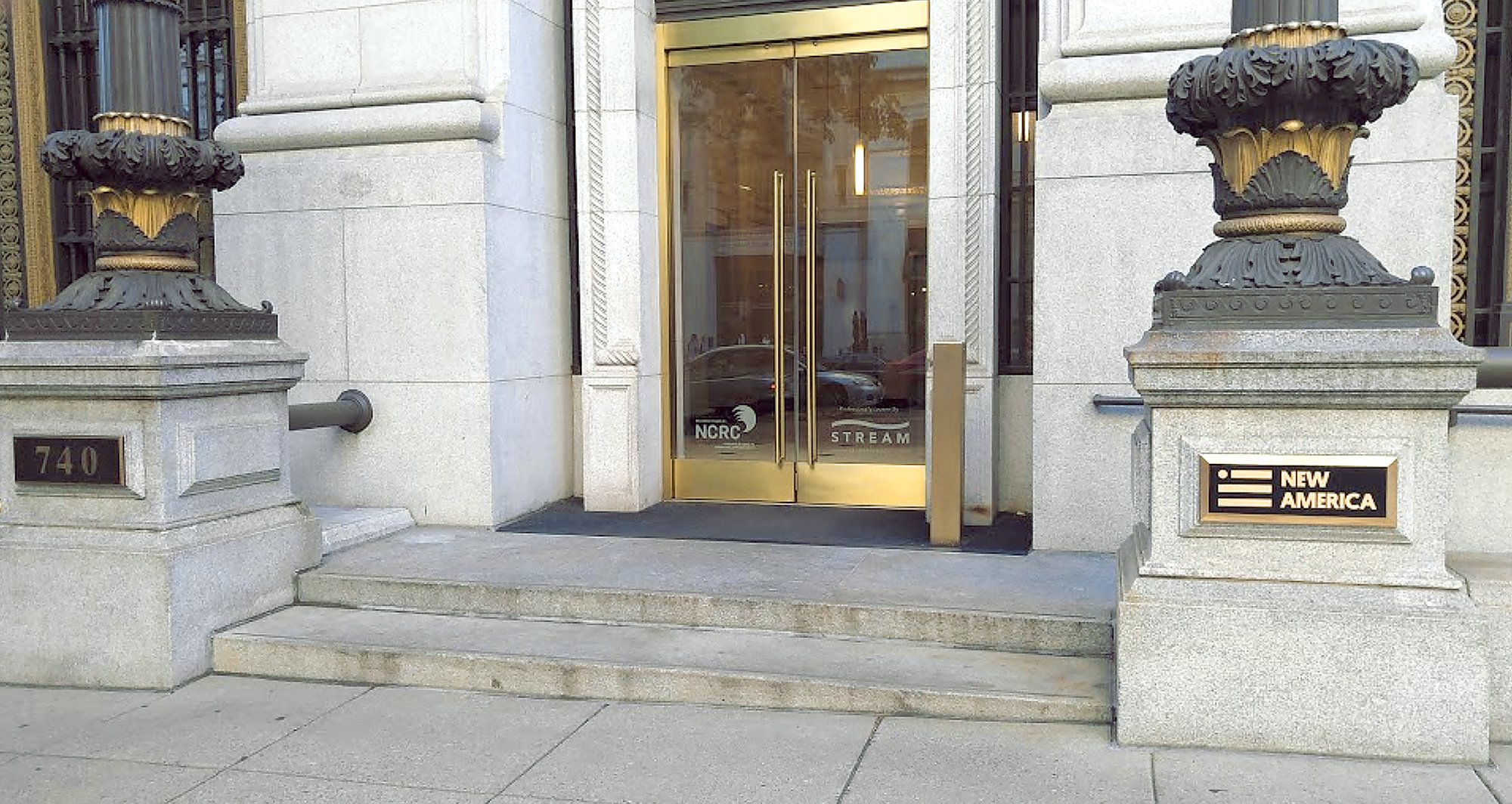
The founders were just as insistent that their organization’s infrastructure be innovative, fashioning it after the New Economy businesses of the era: agile, decentralized, and aggressively lean. Program directors raised their own funds and paid a fraction of their budget to the larger organization. The vibe was entrepreneurial, says Ray Boshara, who joined in the early 2000s and later became a vice president: “Every other organization I had worked for had all these centralized functions. New America had this idea where we can hire all these people who can do their own thing.”
Within a few years, the think tank’s fellows were regularly appearing on the nation’s most elite op-ed pages, liberal and conservative alike, while its policy experts pushed out new ideas such as child savings accounts. Donors, meanwhile, were clamoring to become patrons of the iconoclastic upstart. Here again, New America differentiated itself by corralling money from a new source: Silicon Valley.
Up to that point, tech entrepreneurs out west had largely shied away from DC and its messy politics. “But the government is no longer ignoring us, so we have to get organized,” Eric Schmidt, then CEO of the software firm Novell, explained at the time. In joining New America’s board of directors, Schmidt told the New York Times he didn’t necessarily expect the think tank to champion Silicon Valley’s agenda. As he put it, “The ideas that come out may well include some I might not agree with.”
After Ted Halstead stepped down in 2007, New America tapped Steve Coll, a former managing editor of the Washington Post, to succeed him. The choice adhered to the organization’s taste for the unconventional: No other think tank in town had a working journalist at its helm.
The winner of two Pulitzer Prizes, Coll made New America an even more attractive place for writers and news outlets to affiliate with. But a few of its original ideals began to get obscured during his tenure.
In its earlier days, while New America did accept a small percentage of donations from corporations and their foundations, its leaders were generally leery of getting too friendly with businesses. “Walmart tried to give me a million dollars, and we ended up saying no,” Boshara recalls. “It was intriguing because we’d have access to data we otherwise wouldn’t, but I remember talking to Ted about how it might compromise our brand and independence.” Coll projected a similar reticence. “As I remember it, the consensus was that we should remain wary of corporations,” he says.
After 2009, however, the think tank began landing US government contracts, including millions of dollars’ worth of work from the State Department and the US Agency for International Development to help develop covert wireless networks for dissidents in Iran, Syria, Libya, and Cuba. Given that the organization had long prided itself on not being another Beltway bandit feeding off federal agencies, this shift disturbed some who worried that it signaled mission drift.
“I think government dollars automatically change the character of an institution,” says the Atlantic’s Steve Clemons, one of New America’s first employees. “I was opposed completely, entirely, 9,000 percent. It dumbs down institutions, whether people want to believe it does or not.”
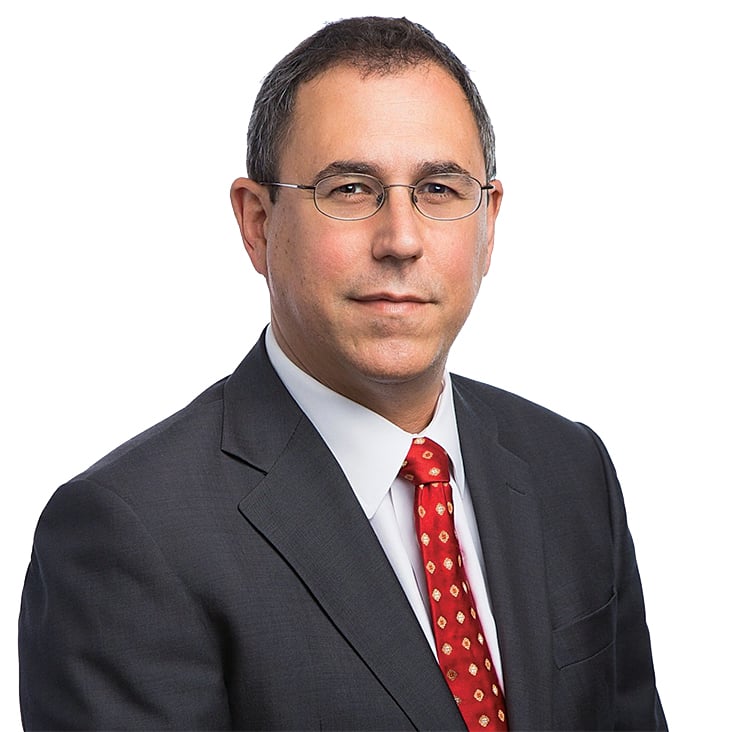
By 2012, New America’s nonpartisan identity would come under strain, too. That year, an internal civil war broke out over Fix the Debt, a high-profile campaign that took a hard-line position on deficit reduction, calling for cuts to Medicare and Social Security.
The campaign’s co-chairs were a bipartisan duo: Democrat Erskine Bowles, a chief of staff in the Clinton White House, and former US senator Alan Simpson, a Republican. In one sense, it was the fullest expression of the think tank living out its dream as a home for ideas of all stripes. One day you might have a staffer from New America’s economic-growth program, which advocated for more federal infrastructure investment, up on Capitol Hill making a pitch about major public financing. The next day, a representative of Fix the Debt might say, “We can’t afford to do anything.”
But in reality, the big tent created complications. Fix the Debt was an enormous publicity generator for New America and was among its biggest moneymakers. The majority of its funders, though, were Republicans, including Wall Street tycoon Pete Peterson. And that caused liberals in the organization to blanch at its association with the right. Board member Bernard Schwartz, a major liberal donor who backed both the economic-growth program and nearly all of the fellows program, became so uncomfortable that he cut ties with the think tank. Eventually, Fix the Debt and its parent program parted ways with New America, too. “Competing pots of money and the political fashions of the day created an incoherent organization,” says one former staffer.
As much as the think tank professed to champion the “radical center,” in practice the mantra had shown its limits.
When Slaughter became CEO in 2013, the mood inside New America turned jubilant. A former State Department official under Hillary Clinton, she had earned a national following after her buzzy 2012 Atlantic cover story about work/life balance, “Why Women Still Can’t Have It All.” Staffers were also excited that Slaughter—a former Princeton dean—arrived with serious academic credentials.
But she inherited some serious organizational dysfunction. Building up the organization’s administrative capacity hadn’t been a priority, even as New America had expanded. Ironing out the infrastructural kinks would be her big test.
One of Slaughter’s first orders of business was moving New America from its modest downtown headquarters to a building a block from the White House. The space had all the amenities of a DC power player: a wrap-around roof deck with views of the Mall, trendy teal accents, and sleek design. The upgrade of 20,000 square feet raised some eyebrows internally, but Slaughter stressed that the extra space was essential. “It embodies who we are and where we want to go and inspires us to get there,” she declared.
Soon, like other think tanks in town, the institution would confront new ethics challenges. Five months into Slaughter’s tenure, a New America policy analyst published a blog post criticizing a partnership between Comcast and an online-education website. Despite objections from New America program directors, according to an e-mail, Slaughter allowed a senior VP at Comcast to write a defensive and self-congratulatory response in the think tank’s weekly newsletter. “That was one of the first portraits many of us had of Anne-Marie’s reflexes and instincts when she’s put in a position that requires confronting corporate power in some way,” says a former staffer. Fuzz Hogan, New America’s spokesman, says the organization “failed to get comment from the subject of a story [Comcast] so the editorial team determined a piece in response [by Comcast] was the most effective and engaging solution.”
Employees would get another portrait the next year when a New America fellow named Steve LeVine was reporting an exposé on Sakti3, a battery company. Its CEO called Slaughter to broach the idea of funding New America but also voiced concerns about LeVine’s reporting. Afterward, Slaughter went to LeVine’s editor to relay the CEO’s objections. As word of the conversation spread, staff felt that a line had been crossed. Slaughter apologized to LeVine for interfering with the story.
“The whole point of it was to have a welcoming place for intellectual misfits.”
Slaughter’s political alliances also became news, in silly as well as serious ways. In 2015, four months after Donald Trump decided to run for President, Slaughter and a colleague met Ivanka Trump at an event in DC. After chatting, Trump asked the women for their shoe sizes so she could send each a pair of boots from her fashion line. They obliged, and when the boots showed up in the mail, Slaughter and her colleague took them home.
A year later, just before the election, WikiLeaks released e-mails revealing that Slaughter had been collaborating informally with Hillary Clinton’s campaign. The e-mail traffic showed Slaughter trying to persuade New York Times columnist Thomas Friedman that the uproar around Clinton’s private e-mail use was overblown and that “everyone” Slaughter knew at State also used private e-mail.
“Tom, I’m not working directly with Hillary’s folks; I can’t, given my position as head of New America. So this reach-out is on my own initiative,” she had written. Friedman told her Clinton’s e-mail situation still didn’t “sit right” with him. Slaughter forwarded their entire exchange to three senior Clinton campaign advisers. “Fyi from Tom F—not great, but useful to know,” she wrote.
Embarrassing as the so-called “Ivanka boots” episode was, at least the tarnish of that faux pas was internal—more of an inside joke. The WikiLeaks incident, though, mortified a number of staffers. It’s not verboten for a think-tank CEO to advocate for a political candidate, but New America had long prided itself on its nonpartisan stance.
As it was, stories were circulating that their boss was gunning for a post in a Clinton White House and grooming their think tank for Hillary’s presidency. Since Slaughter took over, more than a dozen former Obama administration appointees have joined the ranks. A couple, including Cecilia Muñoz, Obama’s top domestic-policy adviser, are among New America’s VPs.
New America “used to be a more accepting place of challenging ideas outside the mainstream,” says a right-leaning researcher who left in 2017. “Whatever tolerance existed is absolutely no longer there. It’s not even about being conservative, but it’s about whether you’re allowed to be outside of this increasingly narrow Obama-coalition thing.”
“We’re not a government in waiting,” says Peter Bergen, a VP. “It’s a big differentiator for us and continues to be.”
Phil Longman, who worked at New America for 18 years until last summer when he departed with Lynn, says you could see the organization watering down its unorthodox brand through its annual retreats. They used to be “freeform” gatherings attended by staff and board members, “punctuated by highly competitive rounds of touch football and also a fair amount of drinking,” he says. “But starting about ten years ago, these fellows retreats gave way to highly formal, scripted sessions in which fellows, if they were allowed to talk at all, were asked to put on dog-and-pony shows for would-be donors. The most original and iconoclastic thinkers were generally left off the program because, well, their ideas were ‘unfundable.’ Eventually, if you weren’t ‘fundable,’ you were gone.”
Over time, a level of anxiety developed in some corners of the organization, clouding the excitement that had marked Slaughter’s hiring. In particular, some worried about the organization’s financial footing.
For one thing, New America had beefed up its administrative teams, adding staff in fundraising and other areas and expanding the organization’s central bureaucracy, a turnaround from its lean beginnings. The number of staffers earning more than $100,000 in reportable compensation jumped from 29 in 2014 to 49 by 2016, according to tax filings. Slaughter earned $535,000 in 2015, her salary increasing 27 percent a year later to $677,000. (The president of the Center on Budget and Policy Priorities, a think tank with comparable revenues, took home $242,000 in 2016.)
There was also the cost of the upscale new DC headquarters. According to financial audits, New America reported rent expenses of $1.3 million in 2014, the last full year it was in its old building, while rent expenses for the new space amounted to $3.3 million in 2016.
Program directors were being asked to hand over more money toward fixed costs. “The culture has really shifted in major ways over the last five years, from a place where the center supports the programs to one where the programs support the center,” says Sascha Meinrath, a former New America vice president who led its tech-policy program from 2008 to 2014.
“When donors give you money, basic courtesy requires that if you know something bad, you say, ‘Here’s a heads-up.'”
While some level of administrative growth is necessary to manage an expanding organization, many have had trouble accepting what they see as outsize ambitions. At the all-staff meeting last September, one employee asked Slaughter if it was a mistake to relocate to the new building. “It’s not putting pressure on our fundraising, and we had to move,” she responded.
It turns out some of the fear may not necessarily have been unfounded. According to internal budget documents, as the organization laid out its 2017 budget, it was seeing red. Revenues had been jumping, from $14 million in 2008 to $38 million by 2016, according to its public tax filings. But so had expenses. Going into 2017, New America was privately forecasting that expenses would badly exceed revenue, leading to a projected drop of $11 million in net assets. Not helping matters was that the organization has no endowment.
Slaughter and her team downplay the concerns, stressing that New America ended up reducing its central-functions budget and exceeding its fundraising goal in 2017. “Nearly doubling revenues means a lot of people have confidence in you,” Slaughter told me this past winter. “It means foundations and individuals are investing in you, so to me that’s the most important metric.”
But it’s not hard to see how anyone in this position wouldn’t have been keen to alienate a big donor.
The souring between Slaughter and Barry Lynn began in mid-2016. Lynn’s Open Markets program, which studied tech giants such as Amazon and Facebook, was organizing a conference where Democratic senator Elizabeth Warren would deliver a keynote on the drawbacks of corporate concentration. Slaughter and the think tank’s chief fundraiser, Meredith Hanley, grew increasingly alarmed by the prospect.
“Just THINK how you are imperiling funding for others,” Slaughter e-mailed Lynn days beforehand, emphasizing that they were “in the process of trying to expand our relationship with Google.” New America had recently increased its donations from big business; 12 percent of revenues came from corporations in 2016, up from 5 percent in 2014.
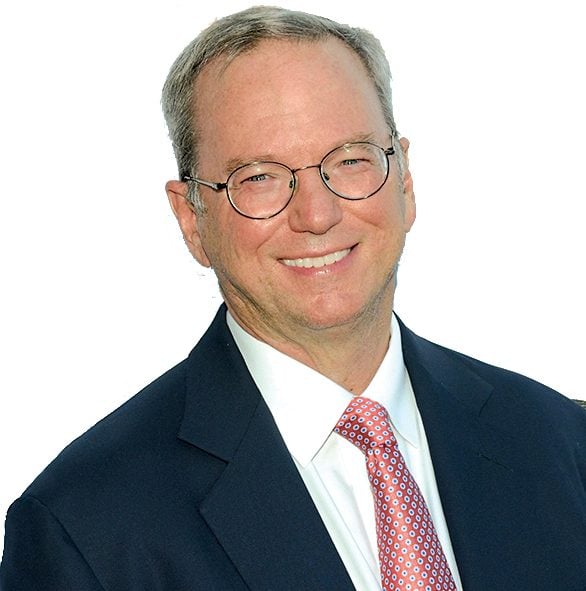
Slaughter demanded in an e-mail that Lynn provide her with talking points to explain to Google why New America hadn’t given it more notice about the conference. Lynn wrote back that the event had been announced publicly and that it had never been standard practice to alert companies about forthcoming events or articles.
That episode ended in a détente. But then Slaughter lost patience with Lynn for good last summer after the EU nailed Google on antitrust violations and Lynn issued his laudatory statement. The release caught the attention of Politico, which cranked out a story noting the strange-bedfellows situation—New America cheering the punishment of a company whose former chairman, Schmidt, was New America’s chairman emeritus.
According to e-mails, Slaughter informed Lynn he was being fired for his “repeated violations of our institutional norms and values concerning notice and cooperation when things that one program does affects other programs.” In other words, not giving a sufficient heads-up to colleagues about what his program was doing. Slaughter said she’d give Lynn two months to quietly spin off his Open Markets program, along with its eight full-time employees: “We will also agree on a common narrative on why this is happening that involves no disparagement by us of you or by you of us.”
But Lynn wasn’t having any of it—he went to the Times with the story, and the drama spilled into public view.
By the time Slaughter returned from her trip to Italy and convened her staff meeting, many employees were not only bewildered—they were embarrassed by their organization’s bumbling, defiant response.
“This story is false,” Slaughter had tweeted the morning the article was published. Several hours later, she tweeted that the “facts are largely right” but the “interpretation is wrong.” After getting blasted on social media for the vague and tone-deaf responses, she issued a full statement two days later, asserting that Lynn had not been fired because of pressure from Google and apologizing for using Trumpian rhetoric to discredit the Times.
Slaughter also pointed to a forthcoming book by one of its then fellows, Franklin Foer. World Without Mind: The Existential Threat of Big Tech argues that Silicon Valley poses a threat to civil society.
The invocation took Foer by surprise. A few months earlier, as he’d been preparing for the book’s release, he’d sensed the think tank was backing away from it. First, he says, the organization informed him that his New York book event would no longer be primarily hosted by New America and that the viewpoints represented on the panel would need to be “balanced.” Foer had attended many other New America book events and knew “balance” was not a typical requirement for what are mainly celebratory events for fellows. Still, he agreed to the conditions.
“But after the fact,” he says, “I learned that the development officer, Meredith [Hanley], had a meeting where she freaked out about the prospect of my book causing blowback for New America from Google and was putting pressure on the fellows program to try to somehow dampen their association with it.”
Then came the Open Markets brouhaha, and suddenly, Foer says, “after running away from my book, they started to run towards it in an effort to launder their reputation.” (Foer now sits on the board of the Open Markets Institute, Lynn’s splinter organization.) A spokesman for New America says, “The people who did attend the meeting Frank heard about secondhand have a different recollection, but the fact is we like Frank, we like his work, we funded the writing of his book, and we promoted it heavily. We believe it is critical to the conversation.”
It’s not as if New America was alone in its interactions with corporations. Brookings and others have been called out in recent years for alleged coziness with funders. For its part, New America has said it doesn’t allow donors to influence its work. “We have never had an instance of a funder shaping what we do,” Slaughter told her staff in September.
“Nearly doubling revenues means a lot of people have confidence in you.”
That month, the think tank’s board hired a management consultant named Jon Huggett to interview nearly 40 people affiliated with the organization. He found that most employees he spoke to felt confident about the organization’s intellectual independence and that Lynn’s departure wasn’t seen as due to funder pressure. “Barry behaved rationally, for himself,” said one. In the end, Slaughter retained the backing of the board—one of its co-chairs at the time suggested in a letter to staff that Lynn had used New America as a scapegoat to advance his own interests.
The organization also conducted a separate, internal review around its funding and transparency practices. As a result of both efforts, it is now disclosing dollar amounts and funding purposes for each of its donors, not just who gives. These changes have earned the think tank praise and higher scores from transparency watchdogs.
Less clear is whether staffers owe donors advance warning about work they might not like. According to Kevin Carey, the VP who led the internal committee, the organization chose not to adopt an official policy on the matter. For some, this left questions around Lynn’s firing still open to interpretation, as well as ambiguity over whether higher-ups could interfere with their work directly or indirectly through a culture of self-censorship. Eventually, several fellows left.
Huggett, the consultant, meanwhile, found that the crisis opened other wounds and that general morale had been clobbered. He told the board he “heard more reasons to back New America from two funders than [from] 30 staff.” Few could speak of a shared mission, and others raised concerns about rising costs and dysfunctional company culture. “We are reactive and opportunistic,” a staffer told Huggett. One founder said: “Money, not mission, drives New America.”
So how do you redefine a nonpartisan think tank in a hyper-partisan age? James Fallows, a longtime board member, says New America is working to figure that out: “You can’t just split the difference between sensible Democratic positions and sensible Republican ones anymore, as you still could do in many areas in the 1990s. The room for finding common ground in Washington has been cut away.”
Whereas it used to play up its distinctiveness, the organization looks more like a follower these days. Its leaders are working on expanding its influence beyond Washington with on-the-ground partners in local communities and “what works” research and events—a popular, apolitical movement embraced by other policy institutes and foundations over the last five years.
Some still feel anxious about the think tank’s finances and future. The organization has had four CFOs in the past five years, and there was an abrupt leadership shake-up on the board last November. While New America has had continued success raising restricted funds for program-specific initiatives, like most nonprofits it has a harder time raising unrestricted dollars. In 2016, an internal committee was tasked with reviewing the organization’s finances, out of recognition, they said, that winning more program grants does not necessarily leave enough money to cover the organization’s fixed costs. Their recommendations to the board included growing more policy programs as well as increasing New America’s corporate-donor pipeline by 30 to 40 prospects annually. (In 2017, 8 percent of funding came from big business.) While the committee noted that the organization was staying afloat thus far by increasing board support and netting big gifts, this was “not a long-term strategy.”
New America’s leadership chalks up the criticism and institutional snags to the inevitable growing pains of expansion. It’s “going through the natural life cycle of any organization,” says Bergen. Think about it as you might a college evolving into a university with a collection of professional schools, Fallows suggests: “A bigger organization just means more complexity of everything.”
Right-sizing may depend on a degree of openness that some believe has been missing. New America has a “social compact” stating that it encourages “fearless feedback” and “frank conversations”—but the management consultant heard varying comments including “I raise concerns and am branded as a trouble maker” and “We do stifle internal critics: Sometimes we fire them.” Moreover, despite New America’s stated values around transparency, when the think tank negotiates severance packages, it includes non-disclosure and non-disparagement agreements—something few people can afford not to sign.
The organization says it has been working on implementing recommendations put forth by the consultant, including writing clearer policies around collegiality. Huggett also suggested that New America establish a committee on “reputation and risk” and make clearer to donors that it will maintain editorial independence, both of which it has done. When asked about the institution’s expectation for notifying funders with a heads-up about things that might upset them, a practice Barry Lynn violated, Slaughter insists there was never a rule around that. “The thing I will say is I love Barry’s work. I’ve cited it and I believe in it,” she adds. “By far the worst part of everything that happened is we lost that work.”
New America has grown in size and scale under Slaughter. One of her goals was to help Washington be more in touch with solutions-oriented enterprises outside the Beltway, and she has positioned New America to try to support innovators in cities and states and connect them to one another. Last year, the think tank welcomed its first class of public-interest technology fellows with data-science expertise, launched a master’s program in global security with Arizona State University, and opened New America Indianapolis, one in a series of local initiatives. Slaughter says she’s proud of helping diversify the organization and of building “a living, breathing network . . . composed of partners and projects and institutions and people all around the country.”
Slaughter has committed to at least five years with the organization, and her half-decade anniversary is coming up this fall. Whether she stays or moves on, the head of the think tank founded to innovate will have to tackle some old-fashioned problems. As one employee interviewed by the management consultant put it: “My biggest hope for New America is to figure out what it wants to be when it grows up.”
This article appears in the July 2018 issue of Washingtonian.

